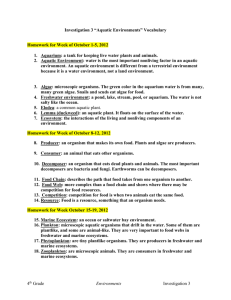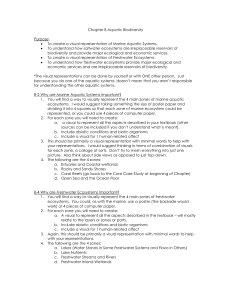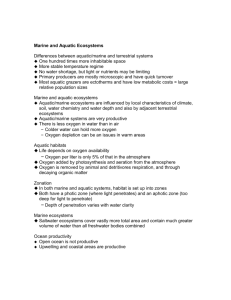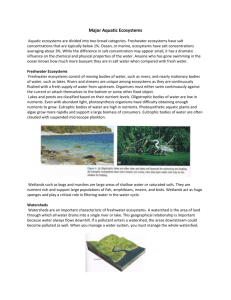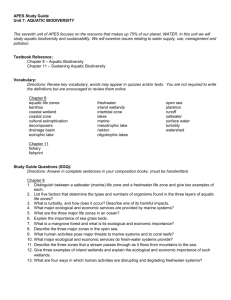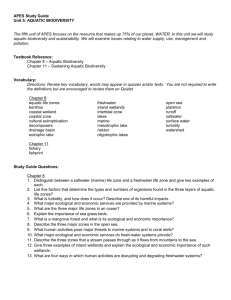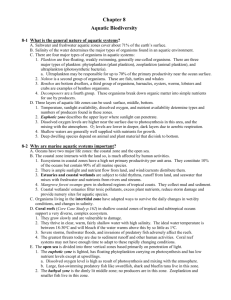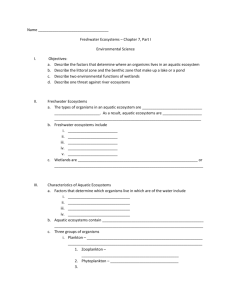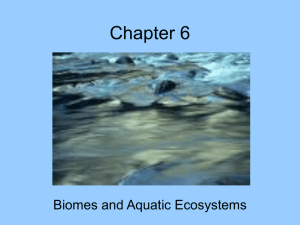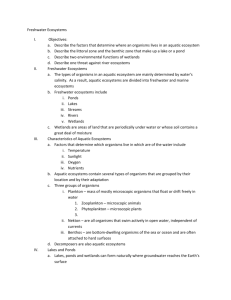aquatic visual project
advertisement
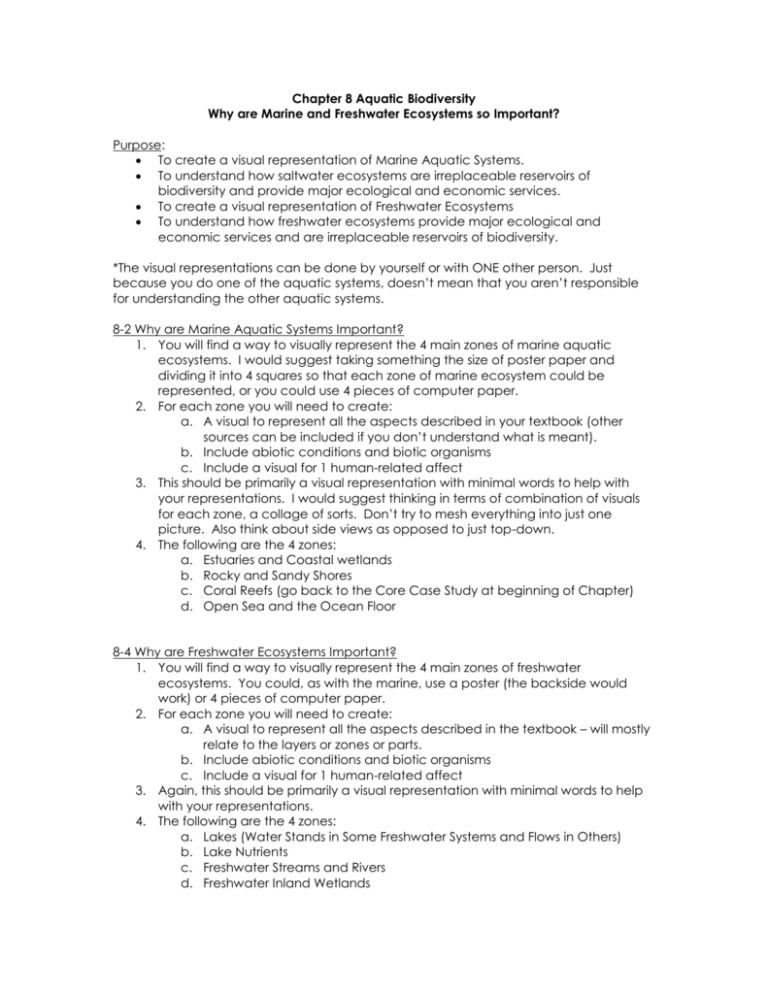
Chapter 8 Aquatic Biodiversity Why are Marine and Freshwater Ecosystems so Important? Purpose: To create a visual representation of Marine Aquatic Systems. To understand how saltwater ecosystems are irreplaceable reservoirs of biodiversity and provide major ecological and economic services. To create a visual representation of Freshwater Ecosystems To understand how freshwater ecosystems provide major ecological and economic services and are irreplaceable reservoirs of biodiversity. *The visual representations can be done by yourself or with ONE other person. Just because you do one of the aquatic systems, doesn’t mean that you aren’t responsible for understanding the other aquatic systems. 8-2 Why are Marine Aquatic Systems Important? 1. You will find a way to visually represent the 4 main zones of marine aquatic ecosystems. I would suggest taking something the size of poster paper and dividing it into 4 squares so that each zone of marine ecosystem could be represented, or you could use 4 pieces of computer paper. 2. For each zone you will need to create: a. A visual to represent all the aspects described in your textbook (other sources can be included if you don’t understand what is meant). b. Include abiotic conditions and biotic organisms c. Include a visual for 1 human-related affect 3. This should be primarily a visual representation with minimal words to help with your representations. I would suggest thinking in terms of combination of visuals for each zone, a collage of sorts. Don’t try to mesh everything into just one picture. Also think about side views as opposed to just top-down. 4. The following are the 4 zones: a. Estuaries and Coastal wetlands b. Rocky and Sandy Shores c. Coral Reefs (go back to the Core Case Study at beginning of Chapter) d. Open Sea and the Ocean Floor 8-4 Why are Freshwater Ecosystems Important? 1. You will find a way to visually represent the 4 main zones of freshwater ecosystems. You could, as with the marine, use a poster (the backside would work) or 4 pieces of computer paper. 2. For each zone you will need to create: a. A visual to represent all the aspects described in the textbook – will mostly relate to the layers or zones or parts. b. Include abiotic conditions and biotic organisms c. Include a visual for 1 human-related affect 3. Again, this should be primarily a visual representation with minimal words to help with your representations. 4. The following are the 4 zones: a. Lakes (Water Stands in Some Freshwater Systems and Flows in Others) b. Lake Nutrients c. Freshwater Streams and Rivers d. Freshwater Inland Wetlands Visual Project Rubric I will use the following criteria to grade your visual representations of the marine ecosystems and freshwater ecosystems. Format (10): Format (see assignment) 5 points Format is followed according to the directions given. 5 points Creativity/Neatness 5 points Exceptional, students strive for originality 5 points Much of the format was Students did not follow followed, but some comthe directions for ponents are missing. format. 2-4 points 0 - 2 points Project is creative and neat. 2 - 4 points Minimal creativity, apparently little effort made on presentation. 0 - 2 points Content (35): Accuracy 20 points All content is accurate, and demonstrates mastery of the subject matter. 17-20 points Most of the content Content is largely accurate, with some incorrect; shows major misunderstandings and misunderstandings of inaccuracies. the material. 8-16 points 0 - 7 points Clarity 5 points Material is written and Topics are mostly displayed in VERY clear understandable, but and understandable occasionally unclear or language. confusing. 5 points 2-4 points Unclear; difficult to follow and understand. 0 - 2 points Thoroughness/ Completeness 10 points ALL topics are Most components are addressed in a thorough included: some but concise manner. information may be left 9-10 points out. 4 - 8 points Topic is inadequately discussed; incomplete work. 0 - 4 points What on EARTH is she looking for?...(Marine ) Estuaries o Basic description o Coastal wetlands – river mouth, inlets, bays, sounds, marshes, mangrove forests, seagrass beds (have 2-3) o High nutrient inputs from rivers, shallow water, sunlight o Changes in tides and river flows, temperature, and salinity o They act to maintain water quality – filter pollutants, excess nutrients and sediments, provide food, habitat, nursery, reduce storm damage and coastal erosion o Human impacts from soil sedimentation and pollution Rocky and Sandy Shores o Intertidal zone o Stressors/challenges on organisms – waves, high and low tides, salinity changes o Human impact o Should be able to tell difference between the 2 types of shore ecosystems in the picture – abiotic aspects o Should include numerous organisms Open Sea and Ocean Floor o Vertical zones – euphotic zone, bathyl zone, abyssal zone – should include what defines each zone within the picture o Upwellings o Deposit feeders and filter feeders Coral Reefs (Core Case Study) o Clear, warm, shallow waters o Reef builders and other organisms o Protect coastlines from erosions o Create habitats o Fishing, tourism o Degradation due to development (runoff sediment clouds water), overfishing, warm temps, ocean acidity What on EARTH is she looking for?....(Fresh) Lakes o Water comes from precipitation, runoff, streams, rivers, fill depressions o Layers – pic should depict the differences Littoral Limnetic Profundal Benthic Lake nutrients o Small supply – oligotrophic Deep steep banks Glaciers and mountain streams Low biodiversity Crystal clear o Large supply – eutrophic Shallow, murky, brown/green, turbid High primary productivity o Human impact Streams and Rivers o Source zone, transition zone, floodplain zone, delta Depict each zone based on description o Organisms o Watershed Freshwater Inland Wetlands o Inland wetalnds – marshes, swamps, prairie potholds, flood plains (include 2-3) o Flooding duration o Organisms o Ecological and economic services (2 or so)
